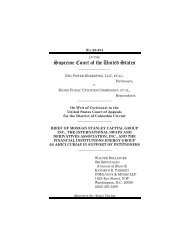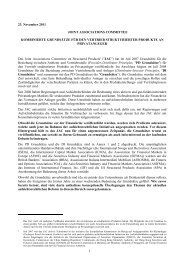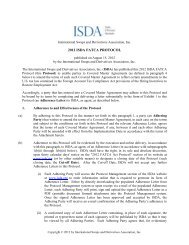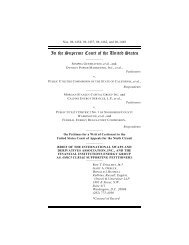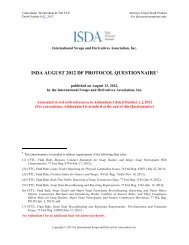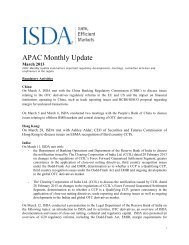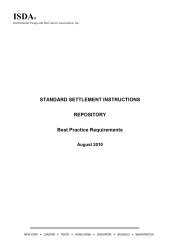24.06. 2011 Ministarstvo financija Republike Hrvatske mr.sc ... - ISDA
24.06. 2011 Ministarstvo financija Republike Hrvatske mr.sc ... - ISDA
24.06. 2011 Ministarstvo financija Republike Hrvatske mr.sc ... - ISDA
- No tags were found...
You also want an ePaper? Increase the reach of your titles
YUMPU automatically turns print PDFs into web optimized ePapers that Google loves.
The di<strong>sc</strong>repancies outlined above may lead to different interpretation by Croatian courts, incase litigation around these issues was to be initiated. This concern further increases thedegree of legal uncertainty.(C) Credit Institutions Act – Article 353 to enter into force the moment the Republic ofCroatia joins the European UnionThe third legal source dealing with netting is given in Article 353 of the Credit InstitutionsAct. It states that during the enforcement of reorganization measures or commencement ofliquidation respectively bankruptcy proceedings in respect of a credit institution fromRepublic of Croatia or any other member state, the governing law applicable to thecompensation and netting agreements shall be the “law that applies to these agreements (thelaw to which these agreements are subject”). The complete text of this Article is provided inAppendix D to this letter.From the perspective of the legal practitioners it is still not clear which law is “the law thatapplies to such agreements” (or “the law to which these agreements are subject”). Wheninterpreting this provision it is possible to reach two conclusions – the first conclusion wouldbe that the law that applies to these (netting) agreements is (any) bankruptcy law (anybankruptcy law that is relevant in respect of an individual bankruptcy entity) and the secondconclusion would be that the law that applies to netting agreements shall be the contractuallaw as agreed between the parties (“lex contractus”). It seems that even in respect of creditinstitutions this provision contains similar interpretation ambiguity as the one de<strong>sc</strong>ribedbetween Article 111 of the Bankruptcy Act and Article 8 of the Financial Collateral Law.We understand that Article 353 shall enter into force upon accession to the EU by theRepublic of Croatia (cf. Article 376 of the Credit Institutions Act; contained in Appendix E tothis letter).Until that moment in time the same problem that stems from inconsistencies between Article111 of the Bankruptcy Act and Article 8 of the Financial Collateral Law also apply to creditinstitutions When Republic of Croatia joins the EU, market participants trading with Croatiancredit institutions shall face another legal risk caused by the unclear wording contained inArticle 353 of the Credit Institutions Act as de<strong>sc</strong>ribed above.What to do next?As a result of legal uncertainties around the treatment of derivatives in the Republic ofCroatia, the Croatian derivative markets are in our view at a competitive disadvantage.Financial institutions and institutional investors inside and outside the Republic of Croatiawho deal with Croatian counterparties cannot be certain to calculate their exposure againstCroatian counterparties on a net basis. The Croatian regulation provides a netting framework,but lacks the legal certainty in respect of the precise timing on the designation or an earlytermination date for transaction in case of a bankruptcy proceedings. Therefore, netting termsset forth in global standard contracts for derivatives and related transactions cannot be fullyrelied upon. At the same time, Croatian market participants who seek to enter into derivativetransactions to hedge their risks are at a disadvantage as they face higher cost for derivativeinstruments and may have restricted access to them as a consequence.Based on the experience of <strong>ISDA</strong> and its members, it is extremely important, especially froma systemic risk perspective, to ensure certainty to market participants as to the enforceabilityof netting and collateral agreements to a large extent.



